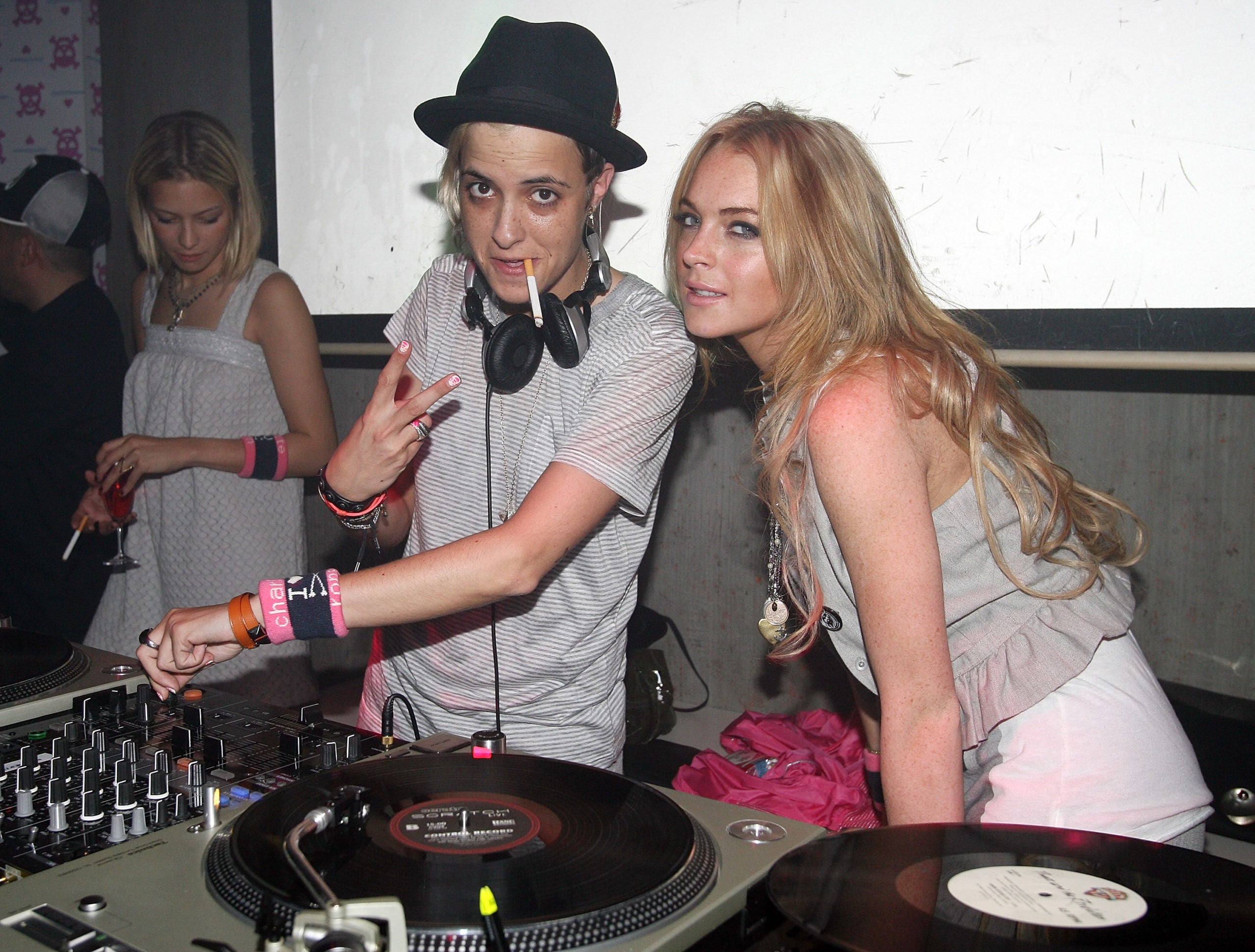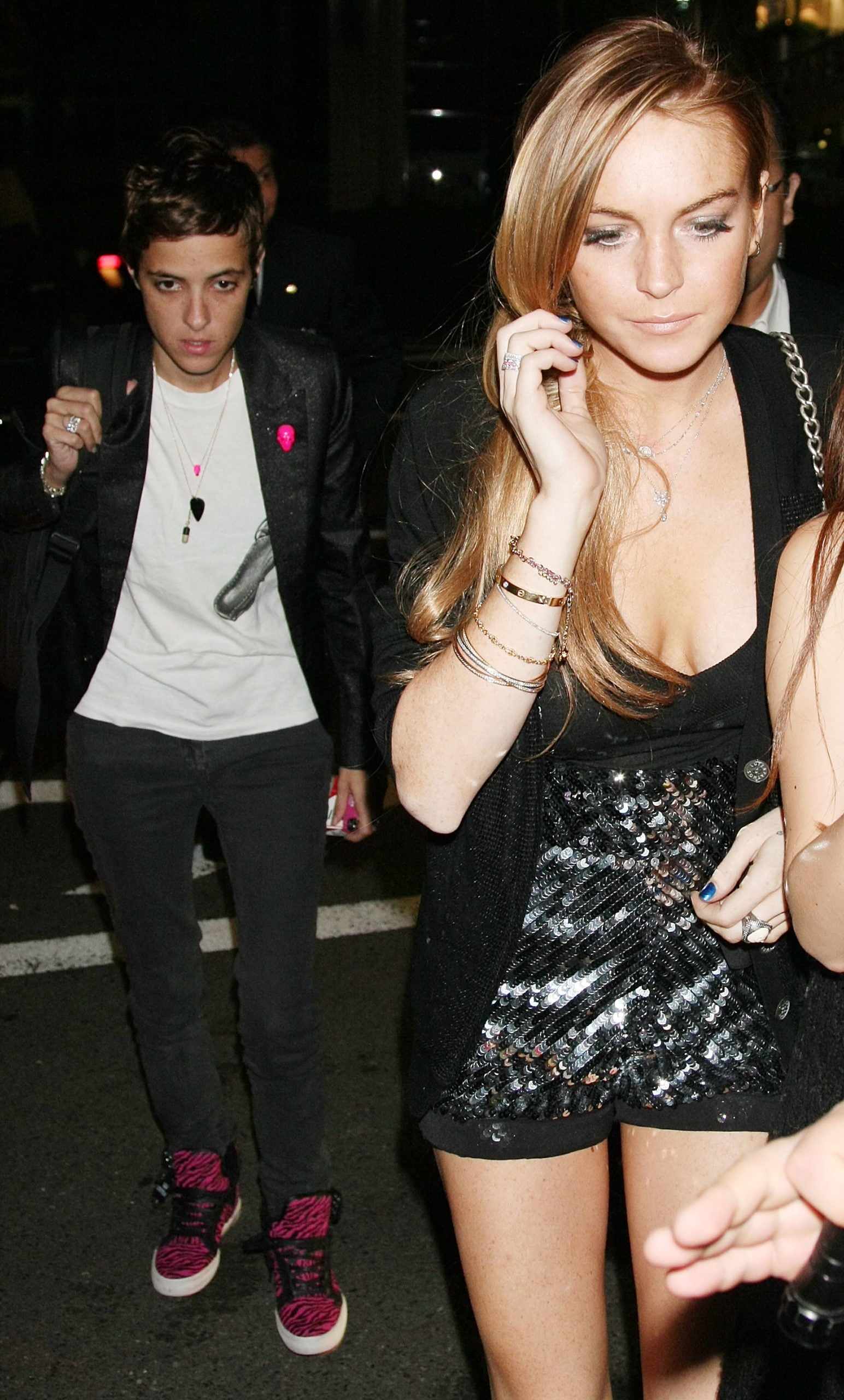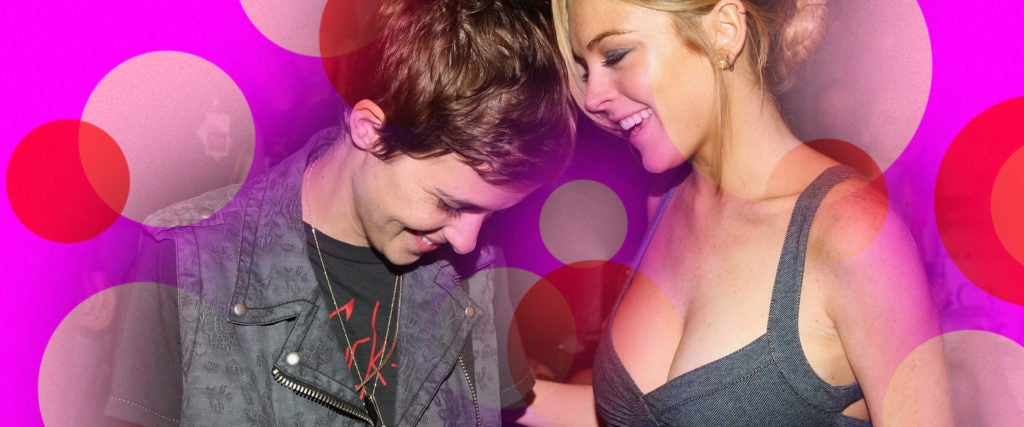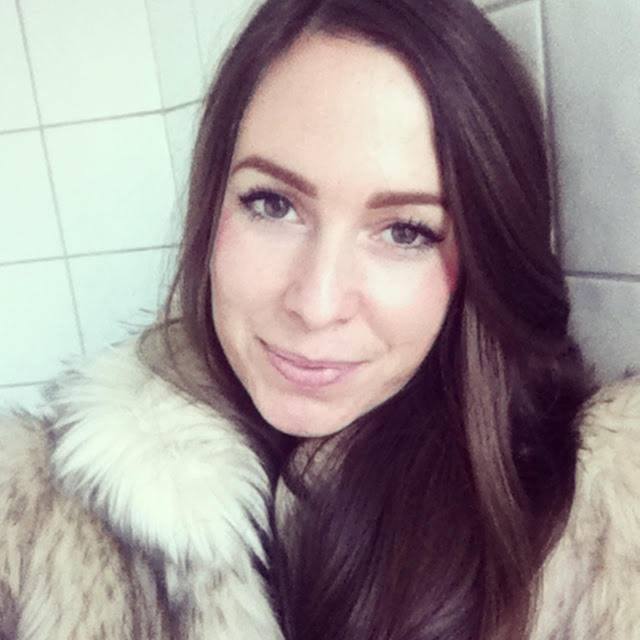Tekla, a 29-year-old genderqueer lesbian, remembers how bleak it was growing up gay in Northern Virginia’s suburbs during the 2000s. President George W. Bush was trying to amend the Constitution to ban gay marriage; it was they heyday for phrases like “That’s so gay!” and “No homo”; and there was a dearth of openly gay public figures, especially women. “We basically had Tila Tequila and t.A.T.u., but there was a sense that t.A.T.u. was hollow and fake, and that Katy Perry’s ‘I Kissed a Girl’ was the best we were ever gonna get,” Tekla explains. “It was slim pickings for your local teen sapphic who was desperate to see some kind of confirmation that queer fulfillment and joy existed.”
But when photos of Lindsay Lohan and Samantha Ronson began circulating in the tabloids in 2007, Tekla felt hopeful about their relationship, and even protective of it. Tired of the “super-femme, airbrushed vibe of t.A.T.u. and the fact that Tila Tequila’s show was so obviously orchestrated for peak salaciousness,” something about the Lohan-Ronson romance felt more authentic. “They seemed more like normal people who weren’t being so aggressively sexualized in a performative way,” Tekla tells me. “I saw a photo of them kissing in one of my mom’s Us or People magazines, and they just looked like normal girls.”
Tekla wasn’t alone, either. During this time, young queer women the world over were pinning their hopes on the year-long celeb romance, starved of examples of genuine lesbian sexuality and romantic normalcy. Some were openly gay and having a difficult time of it, given the conservative cultural landscape; others were realizing their queer leanings for the first time. “Oh No They Didn’t! was rife with so many of us very interested in the whole thing as it unfolded, and I bet most of them are some shade of gay now, like me,” says Taylor, a 28-year-old in Portland who followed the Lohan-Ronson pairing religiously at the time. “It was definitely affirming to see them look so happy together. It was perhaps my first experience with non-fictional queer joy.”
But in looking to Lohan and Ronson for an example of queer joy, these women encountered a slew of negative media narratives about the couple that reaffirmed the homophobic messages of the time, which denied that there was anything aspirational about the pairing — and, implicitly, with lesbian relationships more generally.
The first of these narratives was that the romantic relationship between Lohan and Ronson wasn’t real. Initially, the media ran with a “gal pals” narrative, but this quickly became untenable once the two were kissing and cuddling in public, and especially after they confirmed their relationship. Unable to deny the romance, the media switched to treating their union like a scandal (BUSTED!) and described it as an “experimental phase” for Lohan — a brief dalliance with a woman that would inevitably blow over, because, deep down, Lohan must really be straight.
Lisa, a 36-year-old writer in Ohio who was an out queer woman at the time, remembers finding this framing “incredibly dismissive.” “First of all, it implies that the woman who is ‘experimenting’ couldn’t possibly know her own mind and sexuality well enough to make a conscious choice to be with a woman, because the word suggests some level of confusion,” she explains. “Secondly, it suggests the relationship isn’t real. Even if a woman has only one queer relationship her entire life, that doesn’t mean it wasn’t real, that her feelings weren’t genuine and that it wasn’t a legitimate experience.”
Part of the reason that Lohan was assumed to be merely experimenting, whereas Ronson’s sincerity wasn’t questioned, is that a lot of men really wanted Lohan to be for them. For example, as soon as Lohan turned 18, Rolling Stone described her as “hot, ready and legal!” on a 2004 cover, and later, Eminem rapped, “Lindsay, please come back to seeing men, Samantha’s a 2, you’re practically a 10.” The idea that a conventionally beautiful teen idol who presented high femme might be gay was out of the question in the 2000s, when the stereotype that lesbianism is a backup option for women too ugly to secure a man still reigned.
This was messaging that young, queer women internalized, too. “I do remember at the time finding it suspicious, like she couldn’t really be gay: ‘She’s so pretty, though! And her boobs!’” explains Maddie, a 27-year-old femme-presenting queer woman from New Zealand. “But I doubted my own sexual identity at the time as well, so I was probably projecting.”

It was also relatively culturally acceptable at the time for a woman like Lohan to have sex with other women but not to want relationships with them. As Tekla mentioned, a kind of tantalizing, hypersexual, performative lesbianism was tolerated — think t.A.T.u. and Katy Perry — so long as all the women involved were conventionally beautiful and it was packaged for a male gaze. “It was much more okay to be bi than a lesbian,” Tekla explains. “Being bi was spicy and exciting, and there was a bit of a trend at the time of ‘everyone’s a little bi’ or ‘we don’t need labels.’”
Obviously, this wasn’t genuine acceptance of bisexuality. Rather, it was acceptance of the idea that bi women are open to having sex with other women (hot!) but only really want relationships with men, which was permissible because it centered male desire and presented no real threat to heterosexual hegemony. (Male bisexuality was hardly discussed at the time, and bi men were assumed to be gay.) Being “bicurious” was encouraged, but being a dyke definitely wasn’t.
This couldn’t be clearer in the treatment of Ronson, who presented masc and who, unlike Lohan, was readily understood to be gay (despite identifying as bisexual). That Lohan could love and be attracted to Ronson was treated as a baffling mystery. Perez Hilton, a persistent antagonist of the two, would call Ronson “SaMANtha,” and the aforementioned Eminem lyric was typical of the contempt for Ronson in the tabloid media. “Lots of people said she looked dirty, that she was too skinny, that she looked like a junkie and offered had unspecific complaints about her clothes being juvenile or try-hard,” recalls Ashley, a 27-year-old lesbian in New York City who was out as bisexual at the time. “In hindsight, of course, it had a lot to do with the fact that Lindsay was dating not just a woman but a visibly, openly gay woman. It’s hard not to see these as digs at Sam for presenting as somewhat masc of center.”

All this scorn for Ronson only made Ashley root for the couple harder, though. “Lindsay being so intensely and obviously into her felt transgressive,” she continues. “It validated the notion of non-feminine women as objects of female desire, which wasn’t something I remember seeing in the media growing up.” She says she remembers making the case to family and friends that Ronson was actually really good for Lohan “at least up until the cocaine cake. I definitely wanted to find something aspirational in their relationship.”
But the media made that difficult as well, routinely painting the relationship as a messy, dramatic tryst. Ronson was often cast as a bad influence on lovable, girl-next-door Lohan, held responsible for her drug use and partying by the press and by Lohan’s own father. “I remember [the media] pushed this narrative that there were all these crazy fights and restraining orders, and that [the relationship] was super tumultuous and dramatic,” recalls Olivia, a 33-year-old lesbian in New Zealand. “There were claims that Samantha was using Lindsay to climb the social ladder, stuff like that.”
Sometimes Lohan’s ex, That ’70s Show star Wilmer Valderrama, was treated as Ronson’s foil in that regard, cast as a wholesome type who was good for Lohan (his history of dating much younger women while they were in their teens, including Lohan, didn’t come up for criticism as it might today, because it was completely normalized at the time). “They’d use her relationship with [Valderrama] to push this ‘lesbian relationships are messy’ narrative,” Olivia continues. “It definitely contributed to my impression that people saw lesbian relationships as drama-filled and unhealthy.”
Unfortunately, Lohan herself has since downplayed her relationship with Ronson, saying the two were “more friends than anything,” suggesting that it was indeed a kind of experimental, crazy phase of her life (“I was living in L.A.!”) and denying that she is sexually fluid (“No. I like men!”). In other words, Lohan has essentially reinforced all of the media’s heteronormative narratives about her, a fact that deeply disappoints many of the queer women who looked up to her as teens. “It honestly bummed me out more than I thought it would, learning how Lohan views the relationship,” Maddie tells me. “I think I just love it when very femme, straight-passing women date women, like Ashley Benson and Cara Delevingne.”
As Maddie’s example indicates, these days it’s much less difficult for LGBTQ+ teens to find the type of queer representation they hunger for; in fact, they’re spoiled for choice. If Benson and Delevingne isn’t the example a young queer woman or gender-fluid teen is looking for, then maybe Lena Waithe or Hayley Kiyoko or King Princess or Kehlani or Amandla Stenberg or Ruby Rose will fit the bill.
But it really, really wasn’t always like this, even as recently as a decade ago. “Queer visibility and societal acceptance have changed seismically in an incredibly short amount of time,” Tekla says. “The 2000s/Bush years were a bleak business for a young queer in many ways.” Tekla was out as bisexual back then, but didn’t even have the language yet to identify as a genderqueer lesbian. “Gay marriage was an active debate that came up at school all the time, and I was in the Gay-Straight Alliance (GSA) at school,” they explain. “We had to fight to have the GSA, and I remember some administrative wrangling over whether we were allowed to have it in my freshman year.”

Tekla had a secret girlfriend who couldn’t be out because of her family, and while Tekla’s own parents were more tolerant, things weren’t perfect at her home, either. “Even my mom, while she absolutely knew about me liking girls, completely thought I’d just end up with a dude,” they say. “I was so frustrated by that, because by then I’d told her I was very primarily oriented toward women, but might like the occasional guy. It was that erasure of what I really wanted, over and over.”
For teens like Tekla craving a relationship with a woman, the Lohan-Ronson romance was like an oasis in the desert, and what stood out most wasn’t the cocaine cakes, public fights and restraining orders that the tabloids were so eager to foreshadow; it was the trappings of domestic normalcy. The kiss Tekla remembers seeing in her mother’s tabloid magazine was striking not because it seemed salacious, but because it was so quotidian. “I remember Ronson was wearing a beanie, and that stuck with me for some reason,” they say. “She was just a person!”
Taylor, for her part, was captivated by photos of the duo at Disneyland: two normal-looking women in plaid shirts, walking around the Happiest Place on Earth. “They were there in such a classic relationship-type way,” she says. “I really saw for the first time publicly [a lesbian relationship] that wasn’t fictional.”

Now, Tekla can see that all of their over-investment in Lohan and Ronson’s union was actually a form of self-protection. “I could see the only celebrity romance between women I’d ever seen being erased and mocked right in front of me,” they say. “I think it made me fearful and fiercely protective for my own life and my own future, though I could never have put those words to it at the time.”
“I think I wanted some sort of permission that it was possible to actually be gay,” Tekla concludes, “and that it would be okay if I was.”

